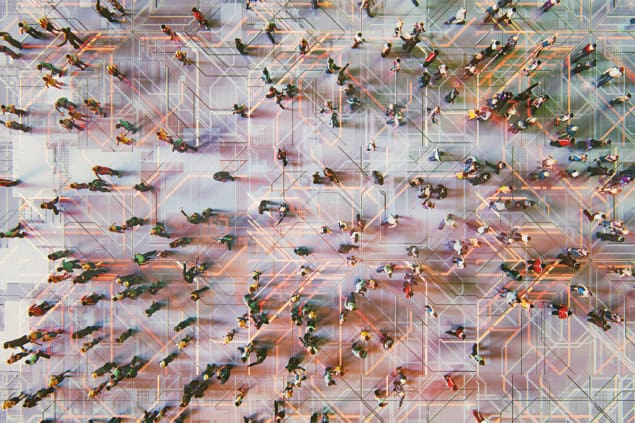
High school students and scientists in the US have used dance to illustrate the physics of topological insulators. The students followed carefully choreographed instructions developed by scientists in what was a fun outreach activity that explained topological phenomena. The exercise demonstrates an alternative analogue for topologically nontrivial systems, which could be potentially useful for research.
“We thought that the way all of these phenomena are explained is rather contrived, and we wanted to, in some sense, democratize the notions of topological phases of matter to a broader audience,” says Joel Yuen-Zhou who is a theoretical chemist at the University of California, San Diego (UCSD). Yuen-Zhou led the research, which was done in collaboration with students and staff at Orange Glen High School near San Diego.
Topological insulators are a type of topological material where the bulk is an electrical insulator but the surface or edges (depending on whether the system is 3D or 2D) conducts electricity. The conducting states arise due to a characteristic of the electronic band structure associated with the system as a whole, which means they persist despite defects or distortions in the system so long as the fundamental topology of the system is undisturbed. Topology can be understood in terms of a coffee mug being topologically equivalent to a ring doughnut, because they both have a hole all the way through. This is unlike a jam doughnut which does not have a hole and is therefore not topologically equivalent to a coffee mug.
Insulators without the conducting edge or surface states are “topologically trivial” and have insulating properties throughout. Yuen-Zhou explains that for topologically nontrivial properties to emerge, the system must be able to support wave phenomena and have something that fulfils the role of a magnetic field in condensed matter topological insulators. As such, analogues of topological insulators have been reported in systems ranging from oceanic and atmospheric fluids to enantiomeric molecules and active matter. Nonetheless, and despite the interest in topological properties for potential applications, they can still seem abstract and arcane.
Human analogue
Yuen-Zhou set about devising a human analogue of a topological insulator with then PhD student Matthew Du, who is now at the University of Chicago. The first step was to establish a Hamiltonian that defines how each site in a 2D lattice interacts with its neighbours and a magnetic field. They then formulated the Schrödinger equation of the system as an algorithm that updates after discrete steps in time and reproduces essential features of topological insulator behaviour. These are chiral propagation around the edges when initially excited at an edge; robustness to defects; propagation around the inside edge when the lattice has a hole in it; and an insulating bulk.
The USCD researchers then explored how this quantum behaviour could be translated into human behaviour. This was a challenge because quantum mechanics operates in the realm of complex numbers that have real and an imaginary components. Fortunately, they were able to identify initial conditions that lead to only real number values for the interactions at each time step of the algorithm. That way the humans, for whom imaginary interactions might be hard to simulate, could legitimately manifest only real numbers as they step through the algorithm. These real values were either one (choreographed as waving flags up), minus one (waving flags down) or zero (standing still).
“The structure isn’t actually specific just to the model that we focus on,” explains Du. “There’s actually a whole class of these kinds of models, and we demonstrate this for another example – actually a more famous model – the Haldane model, which has a honeycomb lattice.”
The researchers then created a grid on a floor at Orange Glen High School, with lines in blue or red joining neighbouring squares. They defined whether the interaction between those sites was parallel or antiparallel (that is, whether the occupants of the squares should wave the flags in the same or opposite direction to each other when prompted).
Commander and caller
A “commander” acts as the initial excitation that starts things off. This is prompted by someone who is not part of the 2D lattice, whom the researchers liken to a caller in line, square or contra dancing. The caller then prompts the commander to come to a standstill, at which point all those who have their flags waving determine if they have a “match”, that is, if they are dancing in kind or opposite to their neighbours as designated by the blue and red lines. Those with a match then stop moving, after which the “commander” or excitation moves to the one site where there is no such match.
Yuen-Zhou and Du taught the choreography to second and third year high school students. The result was that excitations propagated around the edge of the lattice, but bulk excitations fizzled out. There was also a resistance to “defects”.

Aperiodicity: the dance event bringing non-repeating patterns to life
“The main point about topological properties is that they are characterized by mathematics that are insensitive to many details,” says Yuen-Zhou. “While we choreograph the dance, even if there are imperfections and the students mess up, the dance remains and there is the flow of the dance along the edges of the group of people.”
The researchers were excited about showing that even a system as familiar as a group of people could provide an analogue of a topological material, since so far these properties have been “restricted to very highly engineered systems or very exotic materials,” as Yuen-Zhou points out.
“The mapping of a wave function to real numbers then to human movements clearly indicates the thought process of the researchers to make it more meaningful to students as an outreach activity,” says Shanti Pise, a principal technical officer at the Indian Institute of Science, Education and Research in Pune. She was not involved in this research project but specializes in using dance to teach mathematical ideas. “I think this unique integration of wave physics and dance would also give a direction to many researchers, teachers and the general audience to think, experiment and share their ideas!”
The research is described in Science Advances.



